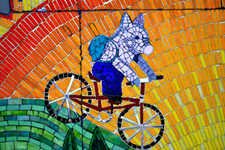A Sampling of KWin Tiling Scripts
KDE Tiling Solutions

Photo by Ralph Katieb on Unsplash
If you want to reap the benefits of tiling desktops on KDE Plasma, check out these KWin script extensions.
A tiling desktop arranges open windows in a grid. Linux abounds with them, including awesome, i3, XMonad, and dwm. Tiling desktops have always been popular among developers, but the average user has been slower to adopt them, probably because tiling is usually controlled from a keyboard rather than with a mouse. In addition, solutions such as virtual workspaces and Plasma Activities often are easier to use. Recently, however, tiling desktops have undergone a revival, partly due to the introduction of tiling in the last few Windows releases, and, more recently, thanks to Pop!_OS’s user-friendly desktop implementation.
But what if you want to use KDE Plasma? Then one of the various script extensions available for KWin, the Plasma window manager, may be just what you need. If some of the scripts described here are not as fully featured as a tiling desktop environment, many are more than enough for most users. What follows is not a complete list, just a representative one. For example, I don't include a family of scripts (among them Quick Tile 2 and Better Quick Tiles), which was designed to add features to KWin’s built-in Quick Tiles, because most of its features are now available routinely in other tiling scripts.
The Benefits of Tiling
Tiling is used primarily to reduce the clutter of open windows on the desktop. On a tiling desktop, each open window is always visible. There is no need for users to search through stacks of windows or to use a utility to minimize all open windows and show only the desktop. In addition, a window can be removed from the grid to float on top of others. If the size of the windows becomes too small, then a virtual workspace can be started to display the overflow. Loosely speaking, tiling can be compared to tabs on a web browser, with the exception that tiling is often harder to learn thanks to the use of keyboard controls.
[...]
